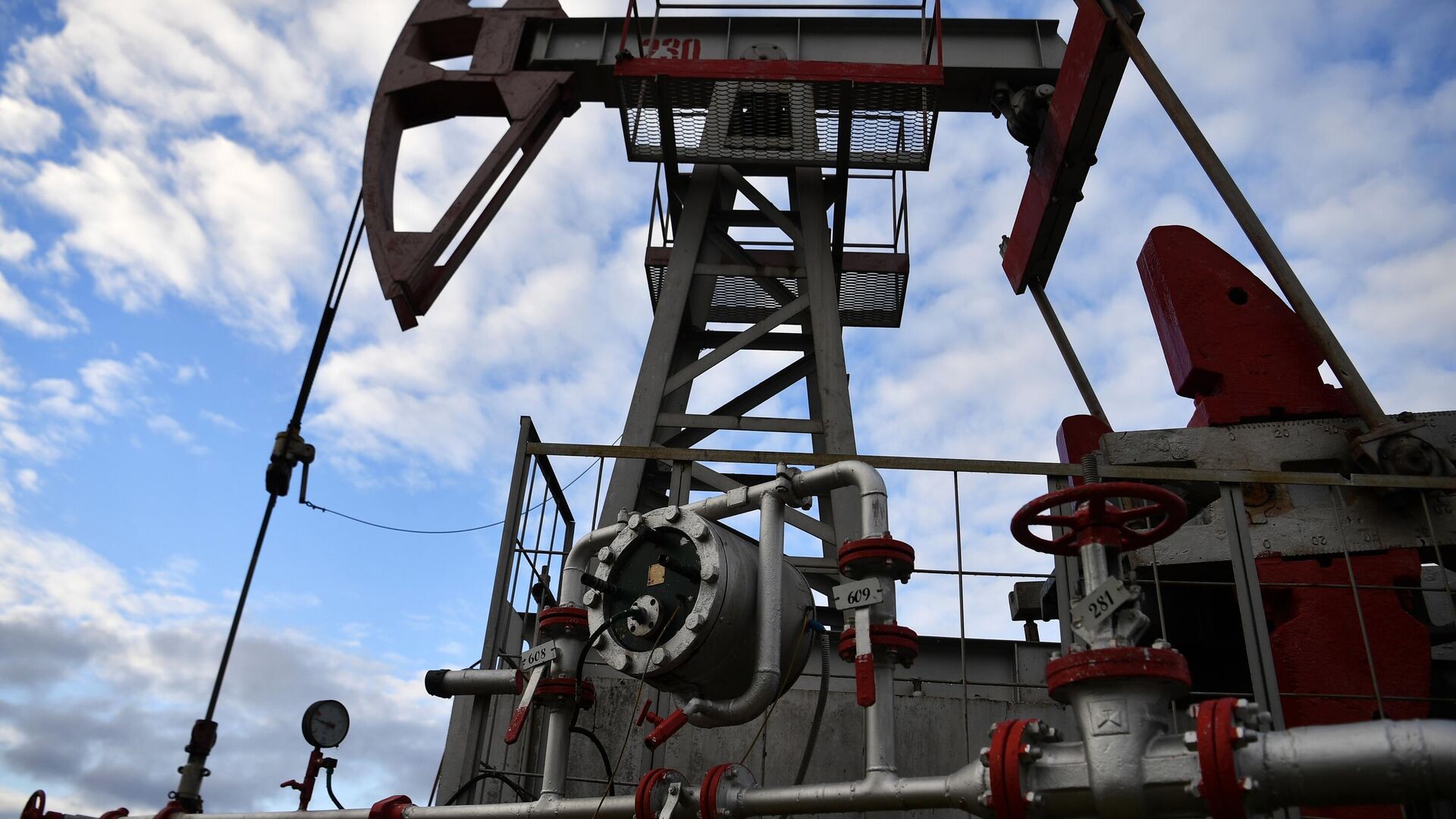https://sputniknews.in/20231026/russian-crude-oil-most-viable-option-for-india-amid-middle-east-tensions-analyst-5082960.html
Russian Crude Oil Most ‘Viable Option’ for India Amid Middle-East Tensions: Specialist
Russian Crude Oil Most ‘Viable Option’ for India Amid Middle-East Tensions: Specialist
Sputnik India
A recent spike in global crude prices in the wake of escalation of tensions between Israel and Hamas justify a case for possible expansion of the energy partnership between New Delhi and Moscow.
2023-10-26T16:39+0530
2023-10-26T16:39+0530
2023-10-26T20:13+0530
israel-hamas war
india
russia
hamas
international energy agency (iea)
reserve bank of india (rbi)
new delhi
oil exporters
global oil production
russian oil price cap
https://cdn1.img.sputniknews.in/img/07e7/08/1e/3930930_0:188:2974:1861_1920x0_80_0_0_f73c0be2754718642bde5020ccc90cbf.jpg
The recent surge global crude prices in the wake of escalation of tensions between Israel and Hamas justify a case for possible expansion of the energy partnership between New Delhi and Moscow, a trading specialist has told Sputnik India. Chandna suggested that it would be a “viable option” for Indian oil marketing companies (OMCs) to look for a “bargain hunt” with major oil producers amid escalation in crude prices.Chandna echoed the sentiment of International Energy Agency (IEA) chief Fatih Birol, who has said that the world would still need Russian oil to flow to the market despite a price cap. Russia has emerged as the top supplier of crude to India this year, as per official data. According to data by Vortexa cited by Reuters, India imported around 38 percent of overall crude requirements from Russia in September.Meanwhile, crude imports from Iraq and Saudi Arabia helped New Delhi meet around 36 percent of its requirements. Spike in Global Crude Prices a ‘Worrying Concern’ for India Chandna said that the increase in global crude prices after the eruption of war between Israel and Hamas was a “worrying concern” for India. The Brent Crude benchmark has hit its highest level since April amid looming uncertainty around supply-side in view of fears that the Middle-East conflict could escalate to involve other regional actors including regional military heavyweight Iran. He explained that an escalation of conflict in the Middle-East could result in higher import bills for New Delhi, a widening current account deficit (CAD), a worsening inflation scenario, in turn leading to the Reserve Bank of India (RBI) possibly increasing lending rates. The specialist estimated that every $10 spike in Brent crude benchmark prices was expected to widen the Current Account Deficit (CAD) of India by 0.5 percent.“That is quite a risk,” he warned. He noted that the ‘Indian Crude Basket’ (an indicator of crude price imports) averaged around $80.1 for the first five months of the financial year 2023-24 (April, May, June, July and August). The OPEC+ announced production cuts of 1.6 million barrels per day in April in order to stabilize the global crude prices. Last October, the major oil producers had announced production cuts to the tune of 2 million barrels per day. Implications for Indian Consumer Chandna reckoned that even though the Indian OMCs were expected to witness a drop in profit margins due to higher crude prices, prices in the Indian retail market were expected to remain more or less stable. “The gross refining margins of the OMCs would definitely register some losses,” added the expert. In spite of global volatility in crude prices in the wake of western restrictions on the selling of Russian crude, India has largely kept itself insulated from the global price surge, which has been credited to New Delhi’s booming crude imports from Russia. The Indian leadership has consistently rejected west-led calls to drawn down its energy partnership with Russia, saying that Russian exports are in line with India’s “energy security”.
https://sputniknews.in/20230525/india-says-its-insulated-from-global-volatility-amid-record-crude-imports-from-russia-2164731.html
india
russia
new delhi
iran
saudi arabia
iraq
Sputnik India
feedback.hindi@sputniknews.com
+74956456601
MIA „Rossiya Segodnya“
2023
Dhairya Maheshwari
https://cdn1.img.sputniknews.in/img/07e6/0c/13/138962_0:0:641:640_100x100_80_0_0_2cb44360dbcdf6d84bf4b299cd045917.jpg
Dhairya Maheshwari
https://cdn1.img.sputniknews.in/img/07e6/0c/13/138962_0:0:641:640_100x100_80_0_0_2cb44360dbcdf6d84bf4b299cd045917.jpg
News
en_IN
Sputnik India
feedback.hindi@sputniknews.com
+74956456601
MIA „Rossiya Segodnya“
Sputnik India
feedback.hindi@sputniknews.com
+74956456601
MIA „Rossiya Segodnya“
Dhairya Maheshwari
https://cdn1.img.sputniknews.in/img/07e6/0c/13/138962_0:0:641:640_100x100_80_0_0_2cb44360dbcdf6d84bf4b299cd045917.jpg
oil reserves in india, oil price, crude oil price, crude oil price today, crude oil futures, crude oil news, israel news, israel war, hamas leader, hamas news, hamas vs palestine, russian crude exports, russian oil price cap, g7 price cap, western sanctions on russia
oil reserves in india, oil price, crude oil price, crude oil price today, crude oil futures, crude oil news, israel news, israel war, hamas leader, hamas news, hamas vs palestine, russian crude exports, russian oil price cap, g7 price cap, western sanctions on russia
Russian Crude Oil Most ‘Viable Option’ for India Amid Middle-East Tensions: Specialist
16:39 26.10.2023 (Updated: 20:13 26.10.2023) While Russia has emerged as India's biggest supplier of crude this year, New Delhi still relies on imports from the Middle-East to meet a significant chunk of its domestic requirements.
The recent surge global crude prices in the wake of escalation of tensions between Israel and Hamas justify a case for possible expansion of the energy partnership between New Delhi and Moscow, a trading specialist has told Sputnik India.
“Even at the current time as the Ural-grade oil is trading higher than the $60 cap by the G7, it is still more competitive than the other benchmark crude prices such as Brent,” said Arpit Chandna, a specialist at Refinitiv, an LSEG (London Stock Exchange Group) business.
Chandna suggested that it would be a “viable option” for Indian oil marketing companies (OMCs) to look for a “bargain hunt” with major oil producers amid escalation in crude prices.
“Russian crude exports to major economies like India will be flowing through and the trend is expected to continue. The Indian OMCs might be looking to buy it,” the trading specialist said.
Chandna echoed the sentiment of International Energy Agency (IEA) chief Fatih Birol, who has said that the world would still need Russian oil to flow to the market despite a price cap.
India is the world’s third-biggest importer of crude in the world, meeting around 85 percent of its domestic requirements through imports from other countries. According to official data cited in media, India’s import bill for oil stood at $10.8 billion in September.
Russia has emerged as the top supplier of crude to India this year, as per official data. According to data by Vortexa cited by Reuters, India imported around 38 percent of overall crude requirements from Russia in September.
Meanwhile, crude imports from Iraq and Saudi Arabia helped New Delhi meet around 36 percent of its requirements.
Spike in Global Crude Prices a ‘Worrying Concern’ for India
Chandna said that the increase in global crude prices after the eruption of war between Israel and Hamas was a “worrying concern” for India.
The
Brent Crude benchmark has hit its
highest level since April amid looming uncertainty around supply-side in view of fears that the Middle-East conflict could escalate to involve other regional actors including regional military heavyweight Iran.
Chandna said that Iran’s involvement in the conflict could result in exacerbating “supply side pressure” on global crude, given the fact that Iran remains an influential actor in regional waterways through which global crude supplies are exported to other nations.
He explained that an
escalation of conflict in the Middle-East could result in higher import bills for New Delhi, a widening current account deficit (CAD), a worsening inflation scenario, in turn leading to the Reserve Bank of India (RBI) possibly increasing lending rates.
“So, higher crude prices would result in higher import bills, which could further result in deficits as India would have to spend more on imports, in turn putting pressure on the current account balance.
The specialist estimated that every $10 spike in Brent crude benchmark prices was expected to widen the Current Account Deficit (CAD) of India by 0.5 percent.
“That is quite a risk,” he warned.
He noted that the ‘Indian Crude Basket’ (an indicator of crude price imports) averaged around $80.1 for the first five months of the financial year 2023-24 (April, May, June, July and August).
“But the crude basket price for India touched around $90.1 per barrel in the first week of September”, noted Chandna. Chandna underlined that production cuts by OPEC+, which involve leading oil producers like Saudi Arabia and Russia, have already tightened the global supplies.
The OPEC+ announced production cuts of 1.6 million barrels per day in April in order to stabilize the global crude prices. Last October, the major oil producers had announced production cuts to the tune of 2 million barrels per day.
Implications for Indian Consumer
Chandna reckoned that even though the Indian OMCs were expected to witness a drop in profit margins due to higher crude prices, prices in the Indian retail market were expected to remain more or less stable.
“Since we are approaching the election cycle, it is anticipated that the Oil Marketing Companies and the government would absorb the costs resulting from higher crude imports and not pass on this to the consumers,” Chandna predicted.
“The gross refining margins of the OMCs would definitely register some losses,” added the expert.
In spite of global volatility in crude prices in the wake of western restrictions on the selling of Russian crude, India has largely kept itself insulated from the global price surge, which has been credited to New Delhi’s booming crude imports from Russia.
The Indian leadership has consistently rejected west-led calls to drawn down its energy partnership with Russia, saying that Russian exports are in line with India’s “energy security”.



